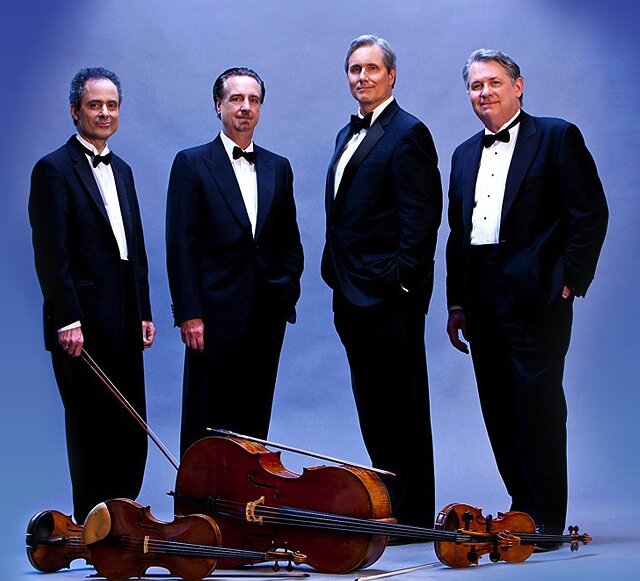
The Emerson String Quartet returned to Meany Theater Tuesday night, performing for the 21st time in their long history with the UW International Chamber Music series(they first came in 1988). The four players—Philip Setzer and Eugene Drucker, violins; Lawrence Dutton, viola, and David Finckel, cello—have been together as a quartet since 1979, the group having been started in 1976 with Setzer and Drucker, Dutton joining them the following year and Finckel in ’79.
Together they are considered one of the world’s great ensembles, and next season will be the last with this lineup. Finckel is retiring to pursue his myriad other activities, notably the artistic directorship with Wu Han of The Chamber Music Society of Lincoln Center. The esteemed Welsh cellist Paul Watkins—soloist, chamber musician and conductor–replaces Finckel after the 2012-2013 season.
But why is the Emerson considered so eminent in its field? It emerged early on as a remarkable group, so it isn’t just longevity–though obviously playing together for 33 years helps the members to know each others’ musical views very well and to have the intuition of a long marriage.
Listening to their performance Tuesday left me thinking that what makes the Emerson great is as much what they don’t do as what they do.
The group performed the late Mozart quartets known as the “King of Prussia:” No. 21 in D Major, No. 22 in B-flat Major, and No. 23 in F Major, plus the Adagio and Fugue, K. 546, and for encore, Mozart’s arrangement of the Bach Fugue in E Major from his Well-Tempered Clavier.
The performance was typical Emerson: that is, close devotion to the style of the composer’s times, with elegance and expression in an era when letting it all hang out was not an appropriate option. There was plenty of energy when required, but it was produced without digging into the strings with force or causing inelegant scritching sounds. They didn’t use long bow strokes when they were not needed. Often a small bow elicited as much lovely sound at a suitable volume, and the smaller bow left more time to shape the sound coming out.
They all used a similar vibrato, not anything frenetic and not all the time. Their tone quality matched, as did the intensity of their playing, with the ebb and flow of the musical line giving one or another prominence. For these quartets, written as a commission from a good amateur cellist who happened to be Friedrich Wilhelm II, King of Prussia, Mozart gave plenty of prominence to the cello line. There were times in this performance where it seemed as though Finckel almost overstepped the line, his cello sang with such resonance.
While the Emerson has no doubt played these quartets many times, the performance sounded freshly minted. Clearly, much thought has gone into just how to play them to bring out Mozart’s wishes, but equally, the players have played together so often that their presentation is relaxed and easy. They have no need to prove anything about themselves.
Phrase endings were meticulously shaped, each one just the right length and dynamic.
This isn‘t to say the performance was perfect. There were a few minor glitches here and there. But, when recordings have been spliced to absolute technical perfection, we know it isn’t that perfection which makes a performance great. It’s musical understanding matched to excellent technical ability, and that the Emerson has in spades.